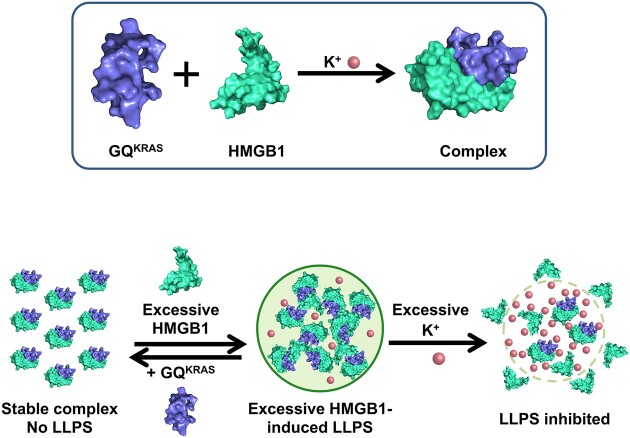- Record: found
- Abstract: found
- Article: found
Mutual promotion of co-condensation of KRAS G-quadruplex and a well-folded protein HMGB1

Read this article at
Abstract
Liquid−liquid phase separation (LLPS) of G-quadruplex (GQ) is involved in many crucial cellular processes, while the quadruplex-folding and their functions are typically modulated by specific DNA-binding proteins. However, the regulatory mechanism of binding proteins, particularly the well-folded proteins, on the LLPS of GQs is largely unknown. Here, we investigated the effect of HMGB1 on the condensation of a G-quadruplex of KRAS promoter (GQ KRAS). The results show that these two rigid macro-biomolecules undergo co-condensation through a mutual promotion manner, while neither of them can form LLPS alone. Fluidity measurements confirm that the liquid-like droplets are highly dynamic. HMGB1 facilitates and stabilizes the quadruplex folding of GQ KRAS, and this process enhances their co-condensation. The KRAS promoter DNA retains quadruplex folding in the droplets; interference with the GQ-folding disrupts the co-condensation of GQ KRAS/HMGB1. Mechanistic studies reveal that electrostatic interaction is a key driving force of the interaction and co-condensation of GQ KRAS/HMGB1; meanwhile, the recognition of two macro-biomolecules plays a crucial role in this process. This result indicates that the phase separation of GQs can be modulated by DNA binding proteins, and this process could also be an efficient way to recruit specific DNA binding proteins.
Graphical Abstract
Related collections
Most cited references44
- Record: found
- Abstract: found
- Article: not found
Liquid phase condensation in cell physiology and disease.
- Record: found
- Abstract: found
- Article: not found
A Phase Separation Model for Transcriptional Control.
- Record: found
- Abstract: not found
- Article: not found
